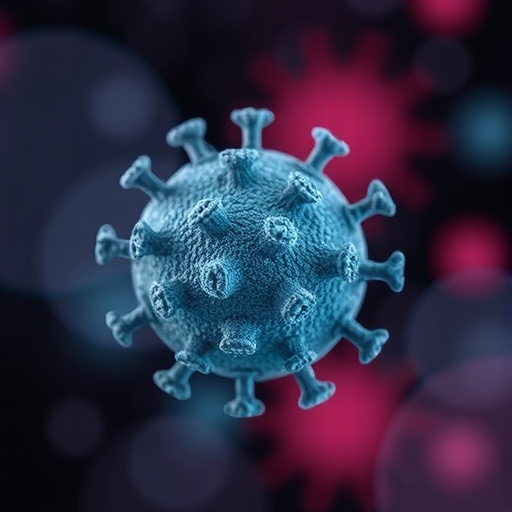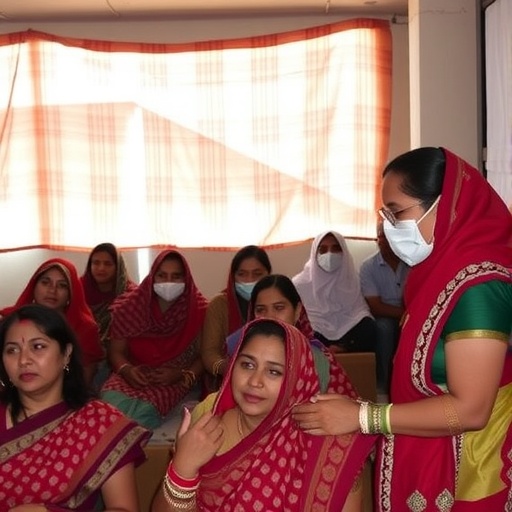In recent years, the global scientific community has witnessed an unprecedented surge of research into the long-term effects of COVID-19, commonly referred to as “long COVID.” Among the myriad symptoms reported by sufferers, a subset has emerged involving disruptions to the menstrual cycle, raising profound questions about the interplay between viral infections and female reproductive health. A groundbreaking study published in Nature Communications by Maybin, Walker, Watters, and their colleagues advances this discourse by proposing a compelling bidirectional relationship between long COVID and menstruation. Their research unpacks the intricate biological mechanisms underlying this association, shedding light on a previously underexplored dimension of the pandemic’s aftermath.
The study contends that long COVID’s impact on menstruation is not unidirectional but rather a complex interplay where the menstrual cycle itself might influence long COVID symptomatology. Historically, viral infections have been linked to reproductive system disturbances, yet the molecular and physiological pathways mediating these effects have remained elusive. The researchers use a multidisciplinary approach integrating immunology, endocrinology, and gynecology to disentangle how SARS-CoV-2 and its long-term sequelae might disrupt menstrual regularity and, conversely, how menstrual biology could modulate the persistence or severity of long COVID symptoms.
Central to the authors’ thesis is the hormonal regulation intrinsic to the menstrual cycle. Estrogen and progesterone, the key ovarian steroids, orchestrate a delicate balance influencing immune responses, vascular function, and tissue repair within the reproductive tract. The study highlights emerging evidence that fluctuations in these hormones during menstruation could alter immune system dynamics, potentially exacerbating inflammatory pathways activated by SARS-CoV-2. This hormonal modulation may, in some instances, amplify the persistence of viral antigens or promote chronic inflammation, factors implicated in sustaining long COVID.
Conversely, the researchers explore how the systemic effects of long COVID—characterized by dysregulated immune responses, endothelial dysfunction, and autonomic nervous system perturbations—can interfere with the hypothalamic-pituitary-ovarian (HPO) axis, leading to menstrual irregularities. The HPO axis is fundamental in regulating ovulation and menstruation, and its disruption can result in a spectrum of reproductive abnormalities ranging from oligomenorrhea to amenorrhea. Data presented in the study suggest that long COVID may impair hypothalamic signaling or pituitary responsiveness, thereby destabilizing the entire hormonal cascade responsible for cyclical endometrial shedding.
A significant portion of the manuscript delves into the immunopathological substrates shared between long COVID and menstrual disturbances. The authors report that aberrant cytokine profiles commonly seen in long COVID—marked by elevated proinflammatory mediators such as interleukin-6 and tumor necrosis factor-alpha—mirror immune alterations during menstruation. This convergence may form a pathological nexus whereby menstrual shedding serves as a biologically vulnerable window for symptom exacerbation. Such phenomena could explain clinical reports of fluctuating symptom severity of long COVID in female patients, synchronized with different phases of their menstrual cycles.
Moreover, the research sheds light on endothelial dysfunction as a pivotal element bridging long COVID and menstrual symptoms. Endothelial cells line blood vessels and regulate vascular tone and permeability, both critical during menstruation when the endometrium undergoes cyclic vascular remodeling and bleeding. Persistent endothelial impairment in long COVID may lead to aberrant uterine blood flow, manifesting as heavier or irregular bleeding patterns frequently self-reported by patients. Understanding this vascular component elucidates yet another layer of complexity and emphasizes the systemic nature of post-viral syndromes.
In addition to vascular factors, autonomic nervous system involvement is implicated in the bidirectional relationship. Dysautonomia, characterized by aberrant sympathetic and parasympathetic nerve activity, is increasingly recognized in long COVID. This imbalance can affect the menstrual cycle by disrupting the neuroendocrine regulation of hormone secretion and uterine contractility, thereby influencing symptoms such as cramping and cycle length. The interdependence of neurological and reproductive systems proposes that menstrual irregularities in long COVID might be symptoms of broader neuroimmune dysregulation.
The authors also discuss the potential role of viral reservoirs or lingering viral components within reproductive tissues. Although direct viral invasion of ovarian or endometrial cells remains to be conclusively demonstrated, the hypothesis that SARS-CoV-2 antigens persist in reproductive compartments is intriguing. Such persistence could chronically stimulate local immune responses, fueling inflammation and consequent menstrual disruptions. This mechanistic scrutiny proposes new avenues for targeted therapeutic interventions, possibly involving antiviral or immunomodulatory agents aimed at reproductive tract pathology.
Importantly, the study acknowledges the social and psychological dimensions intertwined with biological findings. The stress of prolonged illness, including anxiety and depression commonly accompanying long COVID, can independently impact menstrual regularity via psychoneuroendocrine mechanisms. The integrative perspective recognizes the bidirectional interplay expands beyond pure biology, encompassing mental health factors which themselves may feed back into immune and hormonal dysfunction. This holistic understanding calls for comprehensive patient care strategies addressing both physiological and psychosocial domains.
The research methodology employed in this study intertwines clinical data collection with laboratory analyses. The cohort comprised individuals with confirmed long COVID diagnoses tracked longitudinally along with detailed menstruation histories, hormone level assessments, and immune profiling. Cutting-edge techniques such as multiplex cytokine assays, vascular imaging, and neuroendocrine evaluation significantly advance the empirical basis for interpreting complex symptom patterns. Such methodological rigor enhances reproducibility and sets a robust framework for future investigations into sex-specific outcomes of COVID-19.
Insightfully, the authors advocate for standardized protocols in clinical settings to monitor menstrual health in post-COVID patients systematically. Despite mounting anecdotal evidence and emerging scientific data, menstrual disturbances remain underreported and understudied in the context of infectious diseases broadly and COVID-19 specifically. The paper highlights the urgent need to integrate reproductive health metrics into long COVID research and clinical practice guidelines to ensure timely diagnosis and tailored management plans for affected individuals.
The implications of this work extend far beyond the scope of COVID-19, potentially informing understanding of viral impacts on female reproductive health more generally. Viral infections historically associated with reproductive dysfunction—such as HIV, Zika virus, and others—may share mechanistic overlap with SARS-CoV-2 in triggering dysregulated immune and hormonal axes. Crucially, this research underscores the necessity of sex- and gender-disaggregated data in biomedical investigations, recognizing that pandemic-related disease burden and recovery trajectories are profoundly influenced by biological sex differences.
Furthermore, the potential therapeutic angles illuminated in the study inspire innovative treatment paradigms. Modulation of hormonal milieus, immune-targeted therapies, and interventions directed at restoring endothelial and autonomic function could collectively mitigate symptomatology. The prospect of precision medicine approaches tailored to menstrual cycle phases or reproductive hormone levels opens intriguing possibilities for optimizing recovery and quality of life in long COVID sufferers, particularly women.
Crucially, the article also opens a dialogue on health equity and patient advocacy. Many long COVID patients, especially women, have reported feeling marginalized or dismissed by healthcare systems concerning reproductive symptoms. By legitimizing the bidirectional relationship between menstruation and long COVID through rigorous science, this research fosters greater awareness and validation of patient experiences, catalyzing reforms in policy, education, and clinical protocols that prioritize holistic women’s health.
In conclusion, the study by Maybin and colleagues represents a pivotal advance in unraveling the multifaceted relationship between long COVID and menstruation. Their findings illuminate a dynamic interplay governed by hormonal, immune, vascular, and neurological axes, with important clinical and societal ramifications. As the world continues grappling with the enduring shadows of the COVID-19 pandemic, such nuanced insights shepherd the way toward more sensitive, inclusive, and effective healthcare responses for all affected populations.
Subject of Research: The bidirectional relationship between long COVID and menstrual cycle disturbances, emphasizing the biological mechanisms linking SARS-CoV-2 sequelae and female reproductive health.
Article Title: The potential bidirectional relationship between long COVID and menstruation
Article References:
Maybin, J.A., Walker, C., Watters, M. et al. The potential bidirectional relationship between long COVID and menstruation. Nat Commun 16, 8187 (2025). https://doi.org/10.1038/s41467-025-62965-7
Image Credits: AI Generated
Tags: bidirectional relationship between menstruation and long COVIDcomplex interplay of long COVID symptomsendocrinology in long COVID researchgroundbreaking research on menstruation and COVID-19hormonal regulation and viral infectionsimmunology and menstrual healthimpact of COVID-19 on female reproductive healthlong COVID menstrual cycle disruptionslong-term effects of COVID-19 on womenmultidisciplinary approaches in reproductive health studiesphysiological pathways of reproductive disturbancesSARS-CoV-2 and menstrual irregularities





